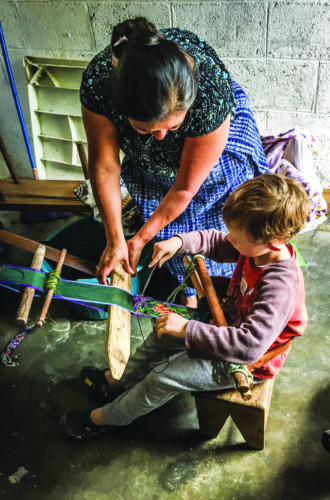
Follow a family’s adventures in Guatemala. Left: Traditional chocolate-making—in Mayan culture, chocolate was consumed as a beverage with chile added. Right: In Guatemala, old American school buses find a new life with bright paint and their own distinctive style.
Our family lived for a month in Antigua, Guatemala, a UNESCO World Heritage Site known for its Mayan and Spanish colonial history. We took daily Spanish classes and participated in our school’s field trips to learn about local history and industry, gradually discovering this new place together.

The main market square in San Martin Jilotepeque where we visited a Denver-based non-profit dental clinic.
Our kids’ memories of Guatemala are predictably concrete. Lucy (3), remembers feeding pigeons in the plaza flanking one of Antigua’s many historic churches. Ray (5) was smitten with hailing tuk-tuks, the ubiquitous local three-wheeled scooters that serve as taxis. Stella, (7), has fond memories of the many stalls hawking colorful makeup in Antigua’s open-air market.

Left: We each had our own Spanish teacher and worked at our own level. Lucy (3), Ray (5) and Stella (7) are pictured with their teachers Pamela, Jessica and Claudia. Right: The Spanish teachers felt like family by the end of the trip—surprising my husband with a cake on his birthday.

Stella carries a tray of dental instruments. In the foreground is one of the many stray dogs that Stella befriended on the trip.
Our kids were happy and engaged by these experiences. But I hoped they’d also absorb something less tangible—an understanding of another culture and how easy it is to find connection and kindness even when people are worlds apart.
About three weeks into our trip, we drove an hour and a half to the small town of San Martin Jilotepeque. There we met my friend Kim Troggio, who runs a Denver-based non-profit, Global Dental Relief (GDR), which provides dental care to kids in developing countries.
In San Martin, GDR’s clinic was in the municipal building along the edge of the central square. At seven busy workstations four dentists and three hygienists cared for about a hundred kids per day. GDR has been running clinics there for a decade, providing regular care to the kids in their treatment populations, but we had arrived when they were setting up a new clinic aimed at kids who had never seen a dentist.
Most of the kids had such advanced tooth decay that the volunteer dentists didn’t treat cavities in baby teeth-—instead they focused on saving permanent teeth. Almost all the kids needed multiple fillings; many had teeth so decayed their teeth had to be extracted. Some had infections due to advanced decay. Once they begin getting regular treatment from GDR, their teeth and gums improve immensely.

One of our Spanish teachers shows Ray how to use her backstrap loom. Men in Guatemala use a larger treadle loom.
I couldn’t help but contrast the teeth of these children with those of my own kids. My two oldest had never had a single cavity. I was struck by the impact of the relatively simple interventions my kids had received that produced such a dramatic difference: regular cleanings, brushing, flossing, and avoiding sugary drinks and food—interventions that these Guatemalan kids would now be getting regularly through GDR.
I was also amazed at the response my kids had. As soon as they realized what was going on, they wanted to help.
GDR accepts volunteers age 12 and older and although our kids weren’t quite of age, Kim put them to work: restocking gloves, preparing dental bibs, setting up trays of dental instruments, and ferrying supplies. The kids were shy, but they all watched and were watched back. A video of Stella carrying dental tools shows three young Guatemalan girls in traditional dress waiting for fluoride treatments. Their heads swivel in unison to watch Stella as she walks past them, while Stella keeps her eyes steadily on the floor in front of her, aware that she is being studied. After her first hour there, Stella realized the clinic’s purpose, and didn’t want to go back to sunny, touristy Antigua. She was resolute that she would spend every waking moment in San Martin, helping however she could.
But we returned to our Spanish school in Antigua. With its familiar routine of classes, field trips, and kind teachers, it was like returning to an extended family.
Back in Denver, as they await their turn in our comfortable air-conditioned dentist’s office, I reflect on my kids’ experience in San Martin. They may not recognize a direct connection between our family’s travels and what they eventually choose to do. But I feel certain that our trip to Guatemala did influence who they will be in the world—curious, adventurous, compassionate, adaptable, and kind. All of this makes me eager for our next trip, and for the privilege of reflecting on such experiences and integrating them into our family life.
 And me? I’ve gotten involved with GDR, trying to help them further their mission. The biggest need GDR has is not for dentists, but for lay volunteers to staff their clinics in Guatemala, Nepal, India, Cambodia and Kenya. I’m hoping someday my kids will join me in one of these projects. www.globaldentalrelief.org
And me? I’ve gotten involved with GDR, trying to help them further their mission. The biggest need GDR has is not for dentists, but for lay volunteers to staff their clinics in Guatemala, Nepal, India, Cambodia and Kenya. I’m hoping someday my kids will join me in one of these projects. www.globaldentalrelief.org
Photos by James and Caroline Hagadorn.
Have you taken a trip with the goal to understand and experience another culture? Contact us if you’d like to share your information for our “Cultural Travel” page (with kids or no kids).




This is a very nice way to teach kids about culture, diversity and globalization.